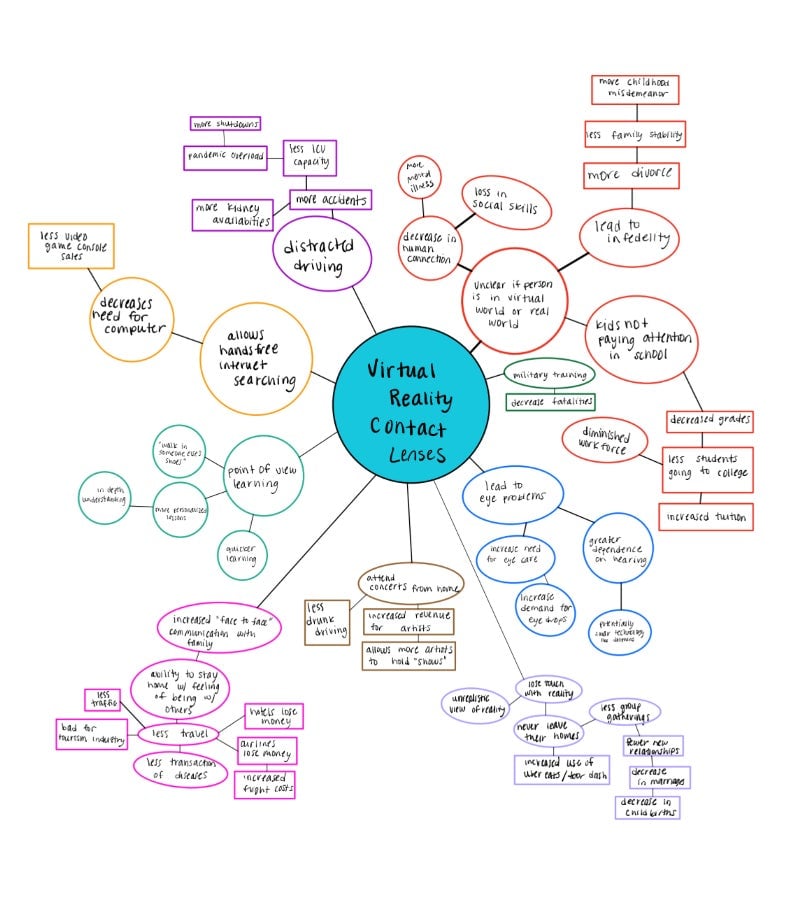Try this exercise to think through the consequences of your creative work
No matter the field you work in, the practice of design offers you many tools to explore and interpret the world, develop a creative point of view, and experiment your way toward new approaches to the problems you want to solve. Using design well means that you embrace responsibility for both the positive and negative outcomes of your work, and its intended and unintended effects. You do your best to think about these implications long before you release your work into the world, and you consider them from diverse perspectives. Of course, this would be so much easier if only you could see into the future.


No matter the field you work in, the practice of design offers you many tools to explore and interpret the world, develop a creative point of view, and experiment your way toward new approaches to the problems you want to solve. Using design well means that you embrace responsibility for both the positive and negative outcomes of your work, and its intended and unintended effects. You do your best to think about these implications long before you release your work into the world, and you consider them from diverse perspectives. Of course, this would be so much easier if only you could see into the future.
The exercise I’m about to show you—the Futures Wheel—will help you to see into the… just kidding. I can’t predict what’s going to happen, and neither can you. But you can train yourself to consciously explore the many possible implications that might result from your creative work. The Futures Wheel will help you do just that by embracing the part of design that involves imagining different futures so you can shape the future you most want to see. Use it to flex your thinking in a new way and to see the significance of your design work regardless of whether you’re working on something big or small.
This assignment has wide applicability, since it’s often helpful to map out the broader context of your work so you can see how it fits into a bigger picture. And there are a few cases when it’s especially critical to use this tool. Use it whenever you are building with an emerging technology that is still developing rapidly and therefore still has unknown impacts. Current examples include machine learning, synthetic biology, blockchain, and social media. Another case is when you are designing new policies, rules, or systems, which often have broad, unpredicted effects. Finally, be sure to use this assignment when you are working with a community that has been harmed in the past, either by neglect or by actively designed changes in their environments or lives, and consider how you can involve these folks in the assignment itself.
First, pick an observable trend happening now that you think will meaningfully influence your future in the next five to 10 years. This could be a really big-picture issue, like advances in autonomous vehicles, robot delivery services, increasing automation, or more healthcare services being delivered remotely via video call. It might be socioeconomic, like the growing imbalance in wealth distribution or the rise of the gig economy. Or your trend could be local, like efforts to build new playgrounds in your neighborhood or the diminishing presence of small businesses in your town.
Write down your trend in a circle in the center of a large piece of paper (allow space for three or four wide concentric zones to be filled in).
Then draw three lines emanating from the center and write down at least three different implications of your trend. “If we see more driverless vehicles in our town, maybe…we’ll have fewer accidents…we’ll need fewer driving teachers…we’ll need to build special lanes just for autonomous vehicles until the public feels they are safe.” You might have more than three— spend as much time as you need to flesh out the space around your center bubble. These are your first- order implications.
Then project out to the next layer by imagining three more implications for each of the first- order nodes. “If we have to build special lanes…we’ll reduce the amount of road space for other cars…we might have to come up with new ways to finance that infrastructure…we might wind up encouraging more people to take public transportation…some people might get angry at the city and start a protest” and so on.
Keep going. Push yourself to explore both negative and positive consequences from each and every node. Don’t be afraid to get to either dystopian or utopian outcomes.
Once you’ve gotten to third- or fourth-order implications, pause and take a step back. What if a few of these implications became true? What would the world look like? What are the implications you prefer? What could you do or design right now that would help nudge the future in that direction? What unintended negative consequences have you uncovered that you most want to prevent? In response to any of these observations, who could you interview to learn more about this?

Try applying this method to any topic you’re currently focusing on. What changes are happening? What new technology are you considering using? What new product or service are you aiming to launch? You’ll find endless uses for this flexible mapping approach.
The Futures Wheel is often used by groups of people who are trying to explore the surface area of a trend and its implications in order to make more informed decisions about how to act or what to create. If you use it on your own, while still valuable, you get just one person’s perspective. A diverse group is particularly useful because you’ll get much more divergence. One person will see the tremendous potential of a new medical procedure to save lives, and another person will see increases to the cost of care.
Neither is right or wrong; thinking about both implications together gives you a better sense of the possible futures. Knowing this gives you more power to design things that can help, rather than harm.
The Futures Wheel was first developed in the 1970s by futurist Joel Barker. It is an exercise in structured imagination. The structure is really important. Most people are pretty good at coming up with first-order implications: the obvious things that might result from a change or a trend. But it requires much more imagination to ladder a whole chain of possible events and to encourage your brain to explore both the utopian and dystopian possibilities from any one change.
The wheel doesn’t tell you what’s most likely to happen. It’s not binary (“this thing I’m making is either really good or really bad”); it allows you to visit and explore the gray areas in between. It quickly takes you from something concrete and observable into the space of imaginative possibilities.
Reprinted with permission from Creative Acts for Curious People: How to Think, Create, and Lead in Unconventional Ways by Sarah Stein Greenberg and the Stanford d.school, copyright © 2021. Published by Ten Speed Press, an imprint of Penguin Random House.